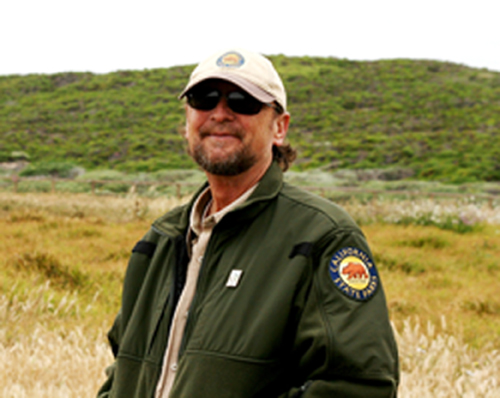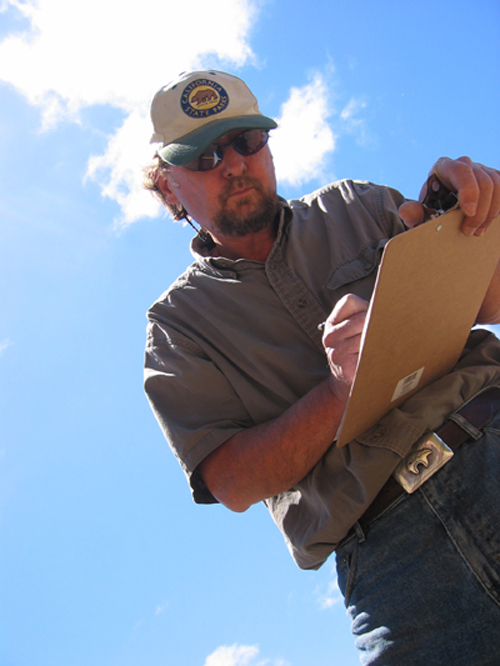
Mark Hylkema, RPA, Supervisor, Cultural Resources Program; Archaeologist/Tribal Liaison
Santa Cruz District, California State Parks
Mark Hylkema is the Supervisor of the Cultural Resources Program and Tribal Liaison/Archaeologist for the Santa Cruz District of California State Parks. He holds an M.A. of Anthropology from San Jose State University and has more than 40 years of experience with cultural resource management, especially focusing on bringing tribal partners back to their homelands in the Bay Area. He has also taught college and university courses as an adjunct professor and has worked with local open space agencies and city governments.
What led you to your field?
My family upbringing and our having traveled to many different countries, as well as camping experiences throughout the Western U.S., fostered an appreciation of our nation’s cultural heritage. This, along with my interests and participation in Native American traditions prior to my professional life, facilitated my career involvements in the field of cultural resources—and more specifically, historic preservation. I have been employed as an archaeologist, tribal coordinator, and supervisor for more than 42 years while also working as an adjunct professor teaching college and university courses on ancestral and contemporary Native American cultures, early California colonial histories, archaeological methods, and anthropology.
How does what you do relate to historic preservation?
I manage cultural resources for 32 state parks in the Santa Cruz District, which extends from San Francisco down the coast to the Monterey County line. These park units consist of rocky and sandy beach ocean shore, coastal grasslands, riparian woodlands, dense redwood and Douglas fir forests, oak woodlands, chapparal, and other habitats in a topography that ranges from the coastal edge to the crest of the Santa Cruz Mountains. The cultural resources within these park units are distributed throughout our jurisdictions and extend into the Pacific Ocean, and include several hundred ancestral Native American cultural heritage sites, industrial archaeological sites (mines, quarries, lime kilns, sawmills, railroad alignments, lighthouses, shipwrecks, and even a shipwrecked sailor cemetery), Spanish colonial sites (including Mission Santa Cruz State Historic Park), Mexican Period adobe buildings, historic ranches and their affiliated structures, and much more. I handle the cultural resources evaluations prescribed under federal and state historic preservation laws and regularly consult with our several tribal communities, while also coordinating grant applications for managing and stabilizing our cultural resources. Given the number of academic institutions in our region, I have found it beneficial to coordinate partnerships with state parks for scientific investigations and cultural stewardship projects. In so doing, I have been able to enhance my own research interests which has led to several professional publications. I am also an editor on the board of the Journal of California Archaeology and served as the President of the Society for California Archaeology during the 2015/2016 term (search scahome.org). Occasionally, I teach courses on historic preservation and its applications to a variety of open space agencies and city governments.
Why do you think historic preservation matters?
A famous Lakota leader—Tatanka Iyotanke (Sitting Bull)—once said, “A people without history is like wind in the grass.” I think that summarizes my outlook, as well.
What courses do you recommend for students interested in this field?
Given my affinity for archaeology, I would recommend courses in anthropology, archaeology, sociology, human osteology, natural resources studies, environmental laws, and help with professional writing and public presentation skills. It is also a good idea to learn the language of the areas where a student may find themselves conducting research or their careers.
Do you have a favorite preservation project? What about it made it special?
In 2008 I was able to work with the State Parks Commission to dedicate a 220-acre Cultural Preserve dedicated to California Native American traditional land management practices. The Quiroste Valley Cultural Preserve in Año Nuevo State Park, and our partnership with the Amah Mutsun Tribal Band and their Native Stewards Corps, has been codified through a Memorandum of Understanding that I wrote, and was signed by the State Parks Director and the tribe in 2021. I am proud of having established a pathway by which the Amah Mutsun Tribe can re-establish their relationship to their homelands, and it has, in turn, become a focus of tribal unity. Concurrently, I am also involved in consultations with the Muwekma Ohlone Tribe who are eager to participate in our interpretive programs and consult on tribal values.
Other projects that I would identify as important and successful include the Woolen Mills Chinatown project in San Jose where a large Chinese residential and merchant community dating from 1887 to 1904 was encountered during a major transportation infrastructural installation. This project occurred during my tenure with the California Department of Transportation (Caltrans) and led to a strong bond between the local Chinese Historical Association and the archaeologists.
Another significant undertaking was the discovery of the Third Church of Mission Santa Clara de Asis in 1989. While working at Caltrans, I was able to record the exposure of the church, sacristy, and cemetery of this early Spanish colonial mission site (circa 1781 to 1818). The cemetery, with some 6,000 Native Americans recorded as buried within it, led to the designation of the area as an archaeological preserve on the Santa Clara University campus. Highway 87 was redesigned to avoid impacting this monumentally significant place.

Can you tell us what you are working on right now?
I am presently wrapping up the analysis and summary of findings for 40 years of archaeological investigations at Año Nuevo State Park, which has a high density of both ancestral Native American and early colonial period archaeological sites. I also continue to mentor graduate students as well as my staff in the Cultural Resources Program in our District. We have progressed into a more effective team better able to address the range of historic preservation priorities. I am also collaborating on several co-authored publications and a book on the indigenous lifeways of the San Francisco Bay region.
How do you think the national historic preservation programs help your community?
By maintaining a sense of place in our world and identifying the contributions and the dignity of our many contributing cultures that together form the populace and greatness of our United States. We learn by example and must therefore maintain a valued sense of our heritage as it is a precious source for wisdom in our future.
Do you have advice for novice preservationists?
Be inspired. Serve by example and don’t let resistance from those with other invested interests discourage you from maintaining your course toward preserving and highlighting our nation’s heritage to the degree possible. Once destroyed, archaeological and historic resources cannot be reconstituted—they are destroyed forever.
The ACHP’s mission is “preserving America’s heritage;” can you give us an example of how your community is preserving its heritage?
We maintain an inventory of the various cultural resources within our 32 state parks and conduct stabilization projects to manage our many historical structures. One example that serves here is our efforts to “Reimagine” Big Basin State Park. This park was the first California State Park, established in 1904, and is, in fact, the epicenter of the conservation movement. It was the first park to have been purchased by the public for the public, with the intent of saving some last stands of old growth redwood forest. In August 2021, the CZU lightening fire burned 98 percent of the park’s 18,000 acres, effectively destroying nearly 100 registered historic structures and features. We are now engaged in a public effort to redesign and build a new State Park. For the first time, we are including several local tribal representatives to serve on our advisory board and have initiated a very public inclusion in our look forward for this historic place.
How does your role as a state park employee shape your work in preservation?
Given the wide range of cultural resources within the park units in my district, I have the unique opportunity to bring our tribal partners back to their homelands and initiate partnerships that allow for a variety of co-management opportunities. Regarding our industrial and agricultural cultural resources, I am responsible for the implementation of projects that must agree with state parks policies regarding historic preservation. My entire position in State Parks is to ensure we are compliant with the regulatory acts; and for projects within our parks, establish guidelines for the protection of our many resources.
How does your role as tribal liaison inform your role in the preservation field?
California environmental laws mandate tribal consultation for all projects, as do federal laws, and our parks district encompasses an area within the territories of several tribal and individual representatives. None of these groups are federally recognized, although two tribal governments are working toward that, but as we at State Parks are aware of the historic circumstances affecting tribal sovereignty, we have chosen to work in partnership with all the folks identified as “Most Likely Descendants” by the State Native American Heritage Commission. As Tribal Liaison for my parks district, I answer to the Tribal Affairs Office in our State Capitol. In partnerships, we are working to designate lands for traditional land management applications and to provide facilities for logistical support, funding opportunities, and public outreach.
Read more Q&A stories about the Preservationists in Your Neighborhood!